#my croops are cleared
Text
Heibekbekehwhekwhwkwjxhywkq.
Also yes. I love his confidence here.
THANK YOU HORI-SENSEI

#ive stolen this one from twitter#sorry not sorry#bunny deku#best deku#babygirl?#my croops are cleared#beauty#THANK YOU HORI#ALL HAIL HORI#bnha#mha#happy new year 2023#deku#izuku midoriya#mirko outfit#miruko outfit
76 notes
·
View notes
Note
mama m sick :( i hav a croop coff n my nose is weawwy stuffy n my hed huts. i no hav covid bu i been sick sinse new year eve n m tiwed a bein sick :(
I’m so sorry sweetheart, being sick is the worst!! Here’s a couple things you can do to feel better:
Take a nice hot shower or bath! Not only will you be clean, but the steam will help to clear out your sinuses and your lungs.
Stay hydrated! Drink some Gatorade, water, or juice. Your body is losing a lot of fluids and electrolytes so you need to replace them!
Let your self rest! Don’t push yourself too far honey, your body needs lots of quiet time and softness right now and that’s okay.
I hope you feel better soon 💕💙
9 notes
·
View notes
Text
DANCE THEATER OF HARLEM
At the end of Geoffrey Holder’s “Dougla,” the finale of their short City Center season, April 4-7, the audience went wild. With good reason, as this amazing piece of theatrical magic is a guaranteed home run. The reconstruction, led by Holder’s son Léo with assists from original Dance Theater of Harlem members and a trove of photos, drawings, and memorabilia in Holder’s expansive collection, which has recently been bequeathed to Emory University.

Dance Theater of Harlem in DOUGLA (1957.) archival photo by Martha Swope
Dance history scholar Charmaine Warren, DTH alumnus Donald Williams, and Kellye A and Keith Saunders, the company’s ballet masters assisted in the loving, beautiful reconstruction. And the DTH cast was supplemented by recent alums Paunika Jones and Malik Berry and members of Collage Dance Collective from Memphis – artistic director Kevin Thomas – coached by Donald Eaton.
The remainder of the program is a testimonial to the growth of DTH’s dancers. Their technique is now assured – except occasionally in partnered turns; their stage presences are powerful, and their energy is sustained throughout. My reservations about the company persistently pertain to the reperertory choices.
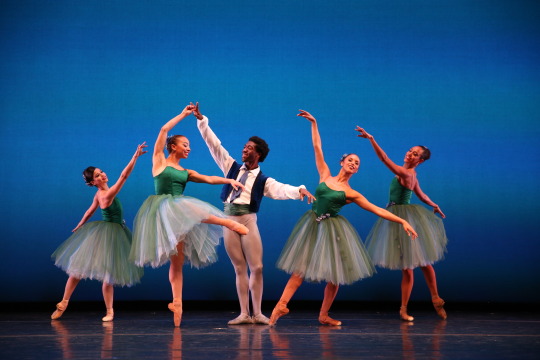
The cast of Balanchine’s VALSE FANTASIE
Although the company no longer needs to prove it can do neoclassical style, the program includes Balanchine’s “Valse Fantasie” to music by Mikhail Glinka – pretty but lightweight Balanchine. The lead couple, here Alison Stroming and Da’Von Doane, dance it well but seem to be subordinating their true natures to the gracious smiles they’ve been coached to do. It’s a well-behaved version of the Balanchine, who himself would probably appreciate the innate pertness, sauciness, and rhythmic playfulness this cast might bring to it, if unfettered.
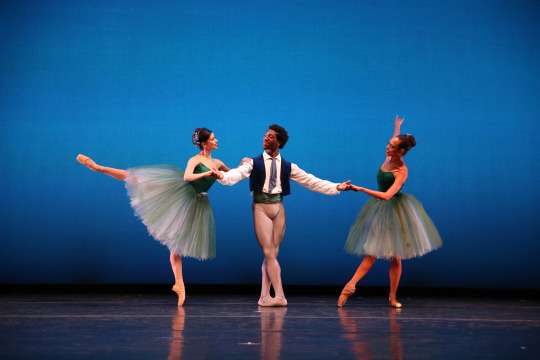
(l-r) Crystal Serrano, Da’Von Doane, and Lindsey Croop in VALSE FANTASIE
Doane dances with a confident ease that amplifies his crisp shapes and clean lines. Stroming is charmingly assertive, and she breathtakingly stretches out her balances. The four coryphées, Alicia Mae Holloway, Stephanie Rae Williams, Amanda Smith, and Yinet Fernandez fluently negotiate Balanchine’s close musical canons and intricate spatial patterns with aplomb.
“This Bitter Earth” by Christopher Wheeldon is set to a musical montage of Max Richter’s “On the Nature of Daylight” and Dinah Washington’s soulful, R&B rendition of the song. Created originally New York City Ballet’s dancers, for Wheeldon’s home company, the choreographic connections have a distinctly European feel. In the hands of DTH, danced on April 6 by Crystal Serrano and Jorge Andres Villarini, the ballet’s phrasing and romantic nuance still has a newness that one hopes will mellow over time into more flowing gestures and fluid transitions.
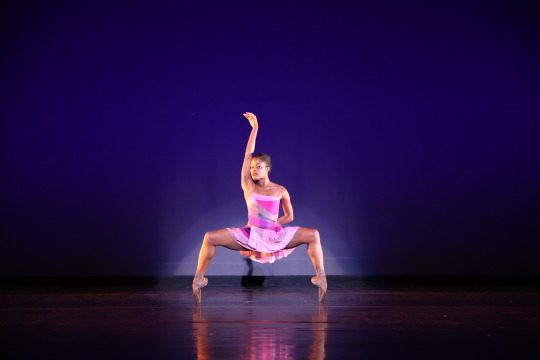
Ingrid Silva in Darrell Grand Moultrie’s HARLEM ON MY MIND
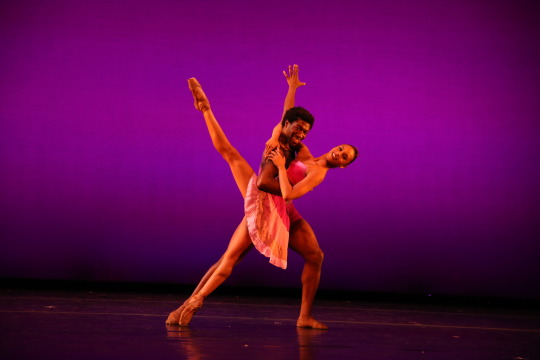
Da’Von Doane and Amanda Smith in HARLEM ON MY MIND
Using the music of Fats Waller, Duke Ellington, Winton Marsalis, and others, Darrell Grand Moultrie – a frequent DTH collaborator – aims to reflect the mystique of Harlem. But he has created a jazz-inflected pointe ballet that choreographically lacks both spatial inventiveness and the musical subtlety the score would suggest. In spite of its choreographic shortcomings, the dancers obvious enjoyment of doing the piece – seen on April 6 – allows it to pop, especially in the lithe solo “Harlem’s Finest,” danced with verve by Anthony Santos, “Duo de Jazzin’,” negotiated deftly by Amanda Smith and Doane, and Ingrid Silva’s red-hot rendering of “Soul of the ‘Hood.”
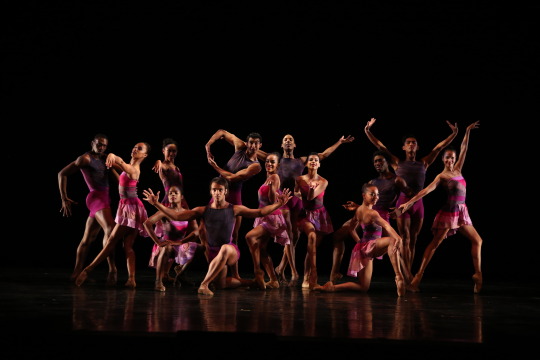
The final, full-cast tableau of Darrell Grand Moultrie’s HARLEM ON MY MIND
When the curtain rises on “Dougla,” it’s as if we’ve entered into one of Holder’s magical paintings, alive with saturated, primary colors – white, red, green, purple, black – in the stunning costumes, also designed by the choreographer, and all set before a series of vivid suns, moons, and palm trees in lustrous projections that fill the rear sky cloth. Under sun-drenched light by Clifton Taylor and propelled by conductor Tania Leon’s arrangement of infectious Afro-Caribbean drums and flutes – played live – a wondrous, fanciful community of mortal creatures struts and glides into the space with walking steps, head nods, and hand gestures that amplify the musical tattoo in their understatement.

The men in Geoffrey Holder’s DOUGLA
The choreography understands precisely how little needs to be done for maximum impact over the soul-stirring percussion. The eight continuous sections of the suite depict lavish preparations for wedding ritual between a warrior prince, Santos, and his paramour, Silva – all in white with her face veiled. Lindsey Croop as Woman in Green oversees the proceedings.

Lindsey Croop as The Woman in Green in DOUGLA

The Women in White in DOUGLA
Three Women in Black with monstrous eyes emblazoned on their flowing trains attend the bride, along with four in white. A dozen men in red skirts, led by Dylan Santos and Doane, do cartwheels around the entire circumference of the stage in a spectacular kinetic display of virility. In 1974, when the dance premiered, separation of masculine and feminine roles was culturally clear, codified, and rigid, so it was appropriate for the women’s dresses to swathe them and the men to strip to just their pom-pom adorned dance belts. Holder truly knew how to please his audience.
Photos by Dave Andrews except where noted
Gus Solomons jr, © 2018
0 notes